Servicios Personalizados
Revista
Articulo
Indicadores
-
 Citado por SciELO
Citado por SciELO
Links relacionados
-
 Similares en
SciELO
Similares en
SciELO
Compartir
Acta Odontológica Latinoamericana
versión On-line ISSN 1852-4834
Acta odontol. latinoam. vol.23 no.3 Buenos Aires dic. 2010
ARTÍCULOS ORIGINALES
Comparative inter-institutional study of stress among dentists
Blanca E. Pozos-Radillo1, Ma. De la Luz Galván-Ramírez2, Manuel Pando1, Ma. De los Ángeles Carrión3, Guillermo J González4
1 Public Health Department in the Health Sciences Centre of the University of Guadalajara, Jalisco, México.
2 Department of Physiology in the Health Sciences Centre of the University of Guadalajara, Jalisco, México.
3 Professional School of Occupational Medicine, University of Barcelona, Spain.
4 Social Sciences Department in the Health Sciences Centre of the University of Guadalajara, Jalisco, México.
CORRESPONDENCE Dra. B. Elizabeth Pozos Radillo Paseo de los Virreyes 706 A-19 Virreyes Residencial, C.P. 45110 Zapopan, Jalisco, Mexico. Tel. and Fax (52) (33) 31 65 07 66 E-mail: litaemx@yahoo.com.mx
ABSTRACT
Dentistry is considered to be a stressful profession due to different factors caused by work, representing a threat to dentists’ health. The objectives of this work were to identify and compare chronic stress in dentists among the different health institutions and the association of stress with risk factors. The study in question is observational, transversal and comparative; 256 dentists were included, distributed among five public health institutions in the city of Guadalajara, Jalisco, Mexico, namely: the Mexican Institute of Social Security (IMSS), the Ministry of Health (SS), the Integral Development of the Family (DIF), the Social Security Services Institute for the Workers (ISSSTE) and the University of Guadalajara (U. de G.) Data were obtained by means of the census technique. Stress was identified using the Stress Symptoms Inventory and the statistical analysis was performed using the Odds Ratio (O.R.) and the chi-square statistic. From the total population studied, 219 subjects presented high levels of chronic stress and 37, low levels. In the results of comparative analysis, significant differences were found between IMSS and U. de G. and likewise between IMSS and SS. However, in the analysis of association, only U. de G. was found to be associated with the high level of chronic stress.
Key words: Occupational stress; Dentists; Chronic stress; Public health.
RESUMEN
Estudio comparativo interinstitucional del estrés en dentistas
La odontologia es considerada una profesion estresante, debido a diferentes factores causados por el trabajo, y representa una amenaza para la salud de los dentistas. Los objetivos de este trabajo fueron: identificar y comparar el estres cronico de dentistas entre las Instituciones de Salud y la asociacion de estres con factores de riesgo. Se trata de un estudio observacional, transversal y comparativo; fueron incluidos 256 odontologos, distribuidos en 5 instituciones de salud publica de la ciudad de Guadalajara, Jalisco, Mexico: Instituto Mexicano del Seguro Social (IMSS), Secretaria de Salud (SS), Desarrollo Integral para la Familia (DIF), Instituto de Seguridad Social y Salud de los Trabajadores del Estado (ISSSTE) y Universidad de Guadalajara (U. de G.). Los datos se obtuvieron mediante la tecnica de censo, durante el ano de 2006. La identificacion de estres se realizo con el Inventario de Sintomas de Estres, y el analisis estadistico se llevo a cabo con razon de momios y X2. Del total de la poblacion estudiada, 219 presentaron niveles altos de estres cronico y 37 niveles bajos. En los resultados del analisis comparativo se encontraron diferencias significativas entre el IMSS vs. U. de G. asi como IMSS vs. SS. Sin embargo, en el analisis de asociacion, solo la U. de G. presenta asociacion con el nivel alto de estres cronico.
Palabras clave: Estres ocupacional; Dentistas; Estres cronico; Salud publica.
INTRODUCTION
Stress is formed by a combination of symptoms occurring simultaneously, and which cause the individual to enter into conflict with his/her individual, work and social environment1. Reports of work-related stress indicate that women suffer more emotional exhaustion, depressions, and anxiety crises (which could turn into chronic stress) than men, who perceive and evaluate each stressful situation faced, and determine the nature of the situation2. The European Union estimates that more than 41 million Europeans suffer from work-related stress, which aggravates the risk of suffering illnesses and of absenteeism due to illness3.
In their profession, dentists are faced with exposure to various chronic stressors, showing stress symptoms because they perceive dentistry as a physically and mentally exhausting profession4. A study in Guatemala indicates that the dentist’s professional environment is arduous, tense and implies a physical and mental deterioration, associating stress as the main cause of illnesses5. According to the estimates of the World Health Organization, Geneva 2000, dentists are found to belong to the occupational group with risk of suicide. There is no obvious explanation for this finding, although stress could be one of the causes6. In London, England, there is evidence that dentists suffer a high level of work-related stress7. Currently, and according to the literature that has been consulted, there are few studies on stress with respect to dentists, and due to its importance as an occupational risk, the purpose of this study is to identify and compare the chronic stress among dentists in the Public Health Institutions in Guadalajara, Jalisco, Mexico, (the Mexican Institute of Social Security (IMSS), the Ministry of Health (SS), the Integral Development of the Family (DIF), the Social Security Services Institute for Workers (ISSSTE) and the University of Guadalajara (U. de G.), and the existing association between stress and its possible risk factors”.
MATERIAL AND METHODS
Study population
The study was transverse, with descriptive and analytical aspects, where the inclusion criteria comprised all the dentists working at the clinics or hospitals of the following Public Health Institutions: the Mexican Institute of Social Security (IMSS), the Ministry of Health (SS), the Integral Development of the Family (DIF), the Social Security Services Institute for Workers (ISSSTE) and the University of Guadalajara (U. de G.). They were selected because of they are a captive population, and the study excluded dentists covering locum positions, assistants, and those working in a private capacity, who would not have an exact location registration. The global extent of the work included 256 dentists, distributed as follows: 90 from U. de G, 68 from IMSS, 44 from SS, 37 from the Integral Development of the Family DIF and 17 from ISSSTE, by means of a census, during the year 2006. A questionnaire was used to determine the following variables: levels of chronic stress, sex, age, marital status, social-economic level, employment duration, working with an assistant, working day, other employment, time for family interaction, performing domestic chores.
Questionnaire
A Stress Symptoms Inventory (SSI) was used, which was prepared and validated by Lipp and Guevara8, translated and adapted for Mexico by Dominguez B. and presented at the Health Department of the National Autonomous University of Mexico in the year 1988, where the validation of the SSI content was presented with a Cronbach’s Alpha of 0.94, which provides an acceptable degree of reliability9. The SSI contains 42 Psychophysiological Symptoms characteristic of chronic stress, classified on the Likert Scale as six options from never to always. The chronic stress levels were governed for each Institution by means of the average, and the standard deviation level was considered as high when it was found to be between (+3S.D., +2S.D. and +1S.D.) and as low when between (-3S.D., -2S.D. and -1S.D.), obtaining the current levels in each Institution.
Statistical analysis
The analysis was carried out in two stages. In the first stage, the information was processed using prevalence and frequency rates, identifying the chronic stress levels existing at each Institution. In the second stage, a bivariate analysis was performed to identify the risk factors; the strength of the association was valued by means of the Odds Ratio (OR), and in order to obtain the risk factors, the high-level and low-level values of chronic stress were compared. By controlling the confusion factors by means of a multivariate logistic analysis, the adjusted coefficient showed the true association between the variables of the study and the high level of chronic stress, thus avoiding the possible confusion effect of the predictor variables, which would confuse any evaluation of the results. In this case, a large quantity of variables is inter-related, which is why an analysis of this type was necessary from all points of view. In the comparative analysis, Chi-square (X2) was used to establish significant differences between the Public Health Institutions and stress levels, using the SPSS programme for statistical analysis.
Ethical Aspects
The study protocol and the informed consent form were reviewed and approved by the Research Ethics Committees of the University of Guadalajara, under reference number OP214, and according to the Helsinki Agreements.
RESULTS
The distribution of the dentists at the health institutions was as follows: sixty-eight from IMSS at nineteen clinics and four hospitals, forty-four from SS at sixteen health centres, thirty-seven from DIF at eight dental service clinics and seventeen from ISSSTE at three dental service clinics and one regional hospital, and ninety at the clinics used by those studying dentistry at the University of Guadalajara at ten dental service clinics. The prevalence rates of the dentist population exposed to chronic stress levels were 85.5% with a high level and 14.5% with a low level (Table 1). With regard to the personal characteristics of the population, the most frequent variables were: age 40 to 49 years; performs domestic chores; female sex; marital status, married; time for family interaction, 50%, and social-economic level, high (Table 2).
Table 1: Frequency of chronic stress levels in dentists by institution. Guadalajara, Jalisco, 2007.
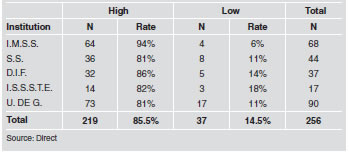
Table 2: Frequency of personal characteristics in dentists by institution, Guadalajara, Jalisco, 2007.
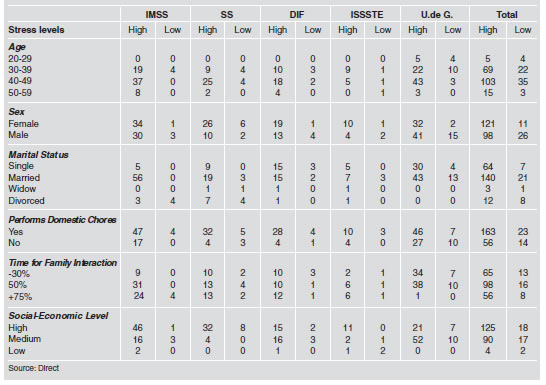
With regard to the employment characteristics, which are shown in Table 3, the most frequent variables were: employment duration from one to ten years; working day from four to six hours; does not work with an assistant and has other employment. The University of Guadalajara was the only Institution which presented variables associated with the high level of chronic stress, O.R. 4.53 in females and O.R. 4.83 for the age range from 40 to 49 years, and p<0.05. Subsequently, a multivariate analysis was performed, in which confusion factors were controlled. It revealed, that female sex and age maintained an association, in addition to the oneto ten-year employment duration variable; this showed an association with high levels of chronic stress, even after controlling the confusion factors, with the following variables: medium social-economic level, has other employment, marital status married and performs domestic chores at home (Table 4).
Table 3: Frequency of the employment characteristics by institution, Guadalajara, Jalisco, 2007.
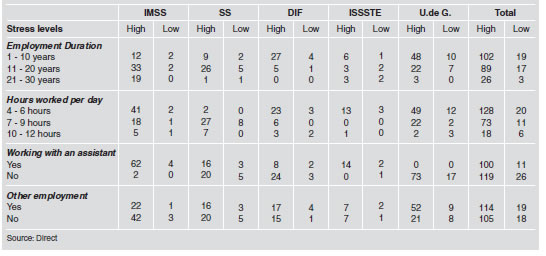
Table 4: Association of characteristics in dentists of the University of Guadalajara, Multivariate Analysis.
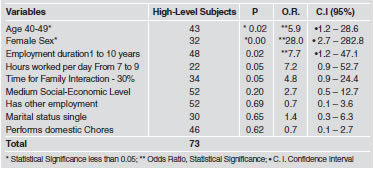
The variables at IMSS, SS, DIF and ISSSTE showed no statistically significant association according to the O.R. and its confidence intervals. Table 5 shows the results of the comparative analysis at the Public Health Institutions, where there is a significant difference between IMSS versus U. de G. and SS.
Table 5: High chronic stress levels by institution.
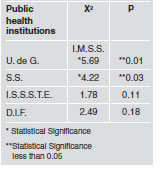
DISCUSSION
Stress is clearly a generalized phenomenon, and has a negative influence on health, cognitive deterioration and efficiency10, 3-7.
In this investigation, dentists at public health institutions showed a major frequency of high chronic stress levels, which is considered to be an alarming situation that could put the health and employment security of dentists at risk. The bivariate analysis determined that the University of Guadalajara was the only institution that reflected a significant association between the variables female sex and age from 40 to 49 years with a high chronic stress level, by means of the O.R. The multivariate analysis showed that these variables maintained their significant association, in addition to the variable: employment duration one to ten years. These results could be due to the particular characteristics of the University of Guadalajara compared to other institutions, since the University of Guadalajara is the only institution where dentists carry out administrative and teaching work apart from clinical work as part of their daily functions, with additional pressure on women who perform domestic chores and the contradictory demands between work and home which can cause intense stress2,3.
These results agree with other studies where reference is made to the fact that in the active population there are certain groups of people who are particularly susceptible to suffering from stress; among those belonging to this category are women3,5. With regard to the age 40 to 49 years and to employment duration one to ten years, there is no clear reference in results. They may be due to subjects being influenced by specific important life events, their commitment to long-term aims and the practical problems of everyday life, associated to the problems of an employment type which could possibly be associated with their responsibilities towards others. The literature consulted mentions that a new study states that people of less than 50 years under high pressure in their employment have almost 70% more risk of developing illnesses than those who live free of stress. This is due to the fact that the stressed workers show signs of major biochemical changes in their organism11. In the population studied, a just over 50% were found to belong to the age group 40 to 49 years. With regard to employment duration, during the first years that dentists perform institutional work, they adapt to the particular characteristics of the work: heavy work; multiple functions for which they must acquire new skills to be able to perform, such as administrative and teaching work; infrequent rest periods; long shifts and working hours; hectic and routine jobs which have little inherent significance; apart from labour relationships with work companions. Being exposed to these stressful work conditions (called causes of stress) can have a direct influence on the health and the safety of the worker. In the dentist’s professional performance during the normal working day, studies show that a major origin of stress is related to the time pressure factor at work, which is the main cause for dissatisfaction associated with patient and colleague relationships7,12.
The inter-institutional analysis showed the IMSS as the institution with staff having the greatest risk of developing high levels of chronic stress compared to U. de G. and SS. Chi-square shows a significant difference of 5.69 between IMSS and U de G., and 4.22 between IMSS and SS, p<0.05. The prevalence rate also shows that IMSS is the institution most affected by the high chronic stress level with a rate of 94%. The reason for IMSS being the most affected institution might be the clinical work-load and the hours worked per day, since whilst an IMSS dentist sees an average of 15 patients with appointments, plus those who arrive without an appointment, which can total 20 patients per day, in 4- to 6-hour shifts, dentists at the University of Guadalajara, DIF and ISSSTE work between 6 and 8 hours per day and dentists at SS work from 7 to 9 hours a day, with a total average of 10 patients per day; representing a lighter work-load and longer lapse between patients. Numerous studies suggest that dentists are submitted to higher levels of tension than many other professions; factors such as the organizational atmosphere, organizational factors, in addition to the type of demands of their particular activities, the inter-personal roles and their ambiguity, among others, can be factors which generate and/or trigger the emotional decline. It is important not to forget that external or personal factors can also have an effect which could influence the results with regard to the chronic stress levels present among dentists at these institutions7,13.
Without denying the importance of individual factors in the perception of the work atmosphere and the reaction to stressful situations, more thorough studies of personal and organizational variables are needed to facilitate associations to be drawn regarding the presence of the high chronic stress level. The precise identification of stress and the most common stressors which cause it, could reduce it by means of an integrated strategy of health promotion and skills development, both professional and for dealing with stress, thus responding to the needs of the dentists and of the institutions affected, by designing steps directed towards minimizing or eliminating the causes generating stress3, 2. The limitation of this study was that it was not possible to establish the causal relations.
ACKNOWLEDGMENTS
This study was possible thanks to the participation of the Public Health Institutions. The author and the collaborators thank all the dentists participating in the study.
1. Sierra J, Ortega V, Zubeidat I. Ansiedad, angustia y estres: tres conceptos a diferenciar. Rev Mal-Estar Subj 2003;3:10-59. [ Links ]
2. Carmen R, Garcia VV, Rodriguez MJ, Barbon RD, y Cardenas EN. Musicoterapia. Una modalidad terapeutica para el estres laboral. Rev. Cubana Med Gen Integr 1997;13:538-543. [ Links ]
3. Aparicio JC. El estres relacionado con el trabajo: un problema creciente. Revista Agencia Europea para la Seguridad en el Trabajo. EU-OSHA Magazine 5 - trabajemos contra el estres. 2002;5:14.
4. Oolevi LT, Ylermi MH, Tapani AH. Musculoskeletal symptoms of dentists assessed by a multisciplinary approach. Community Dent. Oral Epidemiol. 1991;19:38-44 DOI:10.1111/j.1600- 0528.1991.tb00103.x [ Links ]
5. Wong C. Enfermedades que afectan al odontologo guatemalteco como consecuencia del ejercicio profesional. Guatemala: Universidad Francisco Marroquin 2000. Thesis Dental Surgeon. URL: http://www.tesis.ufm.edu.gt/pdf/2939.pdf. [ Links ]
6. Departamento de Salud Mental Organizacion Mundial de la Salud y Toxicomanias. Prevencion del Suicidio: un instrumento para medicos generalistas. Organizacion Mundial de la Salud. Ginebra 2000. URL: http://www.who.int/mental_health/media/general_physicians_spanish.pdf [ Links ]
7. Diaz RM, Perez RE, Lartigue BM. Desgaste profesional en un grupo de odontologos. Rev. ADM 2006;6:220-224. [ Links ]
8. De Almeida CA, Del Bel CA, Rodriguez GR. Prevalence of bruxism and emotional stress and the association between them in Brazilian police officer. Braz Oral Res 2008;22(1):31- 5. DOI 10.1590/S1806-83242008000100006 [ Links ]
9. Meda L. Estres y Salud en trabajadores de la micro y pequena industria de la Zona Metropolitana de Guadalajara. Mexico: Universidad de Guadalajara 1998. PhD Thesis. [ Links ]
10. Romero SH, Jaramillo SR. Clima organizacional, su relacion con el factor humano. Secretaria de Salud CEPROCADEP 2010. URL: http://dgrh.salud.gob.mx/Formatos/MANUAL%20DEL%20PARTICIPANTE%20CLIMA%20ORGANIZACIONAL%20(1).pdf [ Links ]
11. Nava ME. El “grave“ efecto del estres laboral. BBC Mundo Ciencia y Tecnologia 2008. URL: http://news.bbc.co.uk/hi/spanish/science/newsid_7204000/7204544.stm
12. Quiroz RV, Saco MS. Factores asociados al sindrome burnout en medicos y enfermeras del hospital nacional sur este de ESSALUD del Cusco. Revista Semestral de la Facultad de Medicina Humana – UNSAAC 2003;12:11-22.
13. Vara K. Fear, Stress and the well dental office. Northwest Dent 2006;85:3-5. [ Links ]














